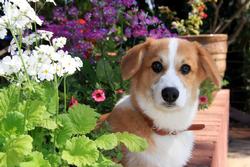
UCCE Master Gardener Program
of Humboldt and Del Norte Counties
Humboldt County Office
5630 South Broadway
Eureka, CA 95503
Phone (707)445-7351
Del Norte County Office
586 G Street
Crescent City, CA 95531
Phone (707)464-4711
Poisonous Plants
Pets and Plants Information
Watch recorded presentation on Poisonous Plants - Link
Toxic and Non-Toxic Plants List - Link
ASPCA Animal Poison Control Center Phone Number: (888) 426-4435 
This list contains plants that have been reported as having systemic effects on animals and/or intense effects on the gastrointestinal tract. Please note that the information contained in our plant lists is not meant to be all-inclusive, but rather a compilation of the most frequently encountered plants. Individual plants may differ in appearance from the photos used on our listings. Please be sure to check the name of the plant to determine its toxicity.
Also, be advised that the consumption of any plant material may cause vomiting and gastrointestinal upset for dogs and cats. Plants listed as either non-toxic, or potentially toxic with mild GI upset as their symptoms are not expected to be life-threatening to your pets.
Who Do You Call?
If you believe that your animal is ill or may have ingested a poisonous substance, or if you have any further questions regarding the information contained in this database, contact either your local veterinarian or
- APCC 24-hour emergency poison hotline at 1-888-426-4435.
- Pet Poison Helpline 855-764-7661 https://www.petpoisonhelpline.com/contact/
Case fee applies, always available - Animal Poison Control 888-426-4435
https://www.aspca.org/pet-care/animal-poison-control
Case fee applies - American Association of Poison Control Centers 800-222-1222

Additional Information and Resources:
Commonly Ingested House Plants
List of Plants Toxic to Dogs
List of Plants Toxic to Cats
List of Plants Toxic to Horses
List of Plants Toxic to Ruminants
Establishing Irrigated Pasture for Horses
Emergency ID for Mushrooms and Plants
Images of Toxic Plants Note: Veterinary Partner is not affiliated with UC Master Gardeners
Toxic Plants (by common name) - Safe and Poisonous Garden Plants
Noxious_weed_disposal_2012-1
2013-Conference-Handout-Top-10-Plants-Poisonous-to-Pets-Pet-Poison-Helpline
Livestock and Poisonous Plants Resources
Please do not feed garden waste to ANY animal unless you are certain it is safe.
UCCE Humboldt/Del Norte Livestock Advisor Jeffery Stackhouse provided the following resources:
BEEF
Article Beef Magazine
Bad Plants for Cattle Article Gardening Know How
SHEEP/GOATS
Ohio State University Article
Sheep and Poisonous Plants
LIVESTOCK
Cornell University Article
Ontario Ministry of Agriculture
NC State Extension
Missouri Extension
Poisonous Plants and Their Risk to Sheep and Cattle
Human Society List of Poisonous Plants
Poisonous Plants for Humans
Toxicity Class
- Major Toxicity: These plants may cause serious illness or death. If ingested, immediately call the Poison Control Center -- (800) 222-1222 -- or your doctor.
- Minor Toxicity: Ingestion of these plants may cause minor illnesses such as vomiting or diarrhea. If ingested, call the Poison Control Center or your doctor.
- Oxalates: The juice or sap of these plants contains oxalate crystals. These needle-shaped crystals can irritate the skin, mouth, tongue, and throat, resulting in throat swelling, breathing difficulties, burning pain, and stomach upset. Call the Poison Control Center or your doctor if any of these symptoms appear following ingestion of plants.
- Dermatitis: The juice, sap, or thorns of these plants may cause a skin rash or irritation. Wash the affected area of skin with soap and water as soon as possible after contact. The rashes may be very serious and painful. Call the Poison Control Center or your doctor if symptoms appear following contact with the plants.
Preventing Exposure
Label Plants
- Before buying a plant, have the store label it with both the common and scientific name.
- Show grandparents and baby sitters where the plant label is. It is very hard for poison specialists to identify plants from a description given on the phone. Know the names of your plants before a poisoning happens.
Children
- If you have small children or curious pets, consider removing toxic plants from your garden and house. House plants should be placed out of reach of the very young.
- Teach children not to put any part of a plant in the mouth. This means leaves, stems, bark, seeds, nuts, berries, and bulbs. Do not allow children to suck nectar from flowers or make "tea" from the leaves. Never chew, or let children chew, on jewelry made from seeds or beans.
Handling Toxic Plants
-
Store labeled bulbs and seeds safely away from children, pets, and food-storage areas. Avoid confusing bulbs with edible onions.
-
Use protective gloves and clothing when handling plants that may be irritating to the skin. Wash clothes afterwards.
-
Discard plant leaves and flowers in a safe way so that children and pets cannot get to them.
-
Smoke from fires made of twigs and other parts of poisonous plants, including poison oak, can irritate or harm the eyes, throat, and other parts of the body.
Other Information
- Do not eat plants or mushrooms collected outdoors unless you are certain they are safe.
Treatment for Exposures
What to do for a plant poisoning
If the victim is choking and cannot breathe, call 9-1-1
Treatment for Exposure: Link to UC Davis Document
Meanwhile, call the Poison Control Center: (800) 222-1222
If you are advised to go to an emergency room, take the plant or a part of it with you (take more than a single leaf or berry). Take the label, too, if you have it. The correct name can result in the proper treatment if the plant is poisonous. If the plant is not dangerous, knowing the name can prevent needless treatment and worry.
